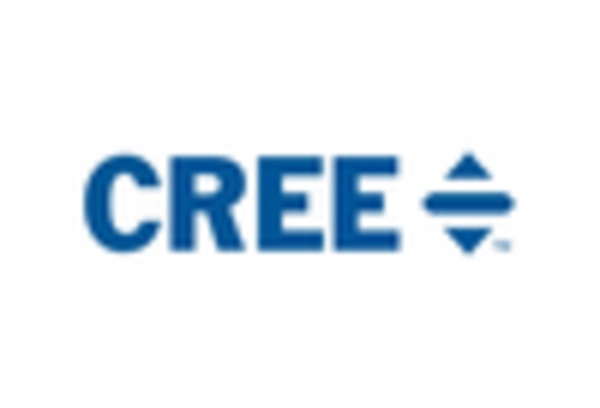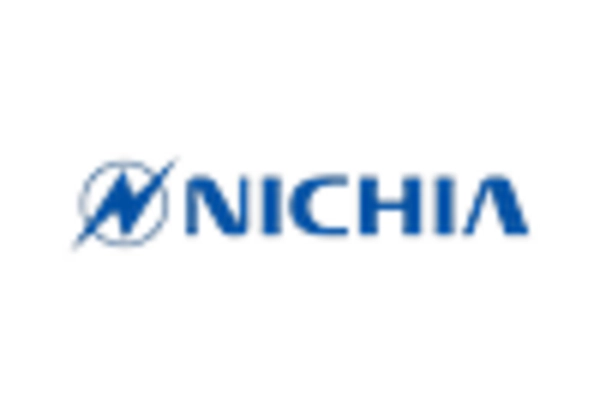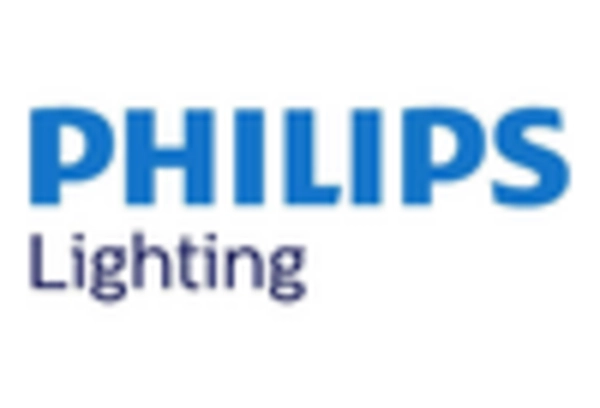Diverse Application Areas
The LED Chip Market is characterized by its diverse application areas, which are expanding rapidly. LED chips are being utilized in various sectors, including automotive, healthcare, and horticulture, among others. For instance, the automotive industry is increasingly adopting LED chips for headlights and interior lighting, enhancing vehicle aesthetics and safety. In healthcare, LED chips are used in medical lighting and phototherapy, improving patient outcomes. Market analysis suggests that the horticultural lighting segment is projected to grow at a CAGR of 15% as more growers recognize the benefits of LED technology for plant growth. This diversification of applications is likely to drive the overall growth of the LED chip market.
Technological Advancements
The LED Chip Market is experiencing rapid technological advancements that enhance performance and efficiency. Innovations in chip design and manufacturing processes are leading to higher luminous efficacy and lower energy consumption. For instance, the introduction of quantum dot technology is improving color rendering and brightness, making LED chips more appealing for various applications. As a result, the market is projected to grow at a compound annual growth rate (CAGR) of approximately 10% over the next five years. This growth is driven by the increasing demand for high-quality lighting solutions in residential, commercial, and industrial sectors. Furthermore, advancements in smart technology integration are enabling LED chips to be used in intelligent lighting systems, further expanding their market potential.
Energy Efficiency Regulations
The LED Chip Market is significantly influenced by stringent energy efficiency regulations imposed by governments worldwide. These regulations aim to reduce energy consumption and greenhouse gas emissions, thereby promoting the adoption of energy-efficient lighting solutions. As a result, LED chips, known for their low power consumption and long lifespan, are becoming the preferred choice for consumers and businesses alike. According to recent data, the implementation of energy efficiency standards has led to a 30% increase in LED chip adoption in commercial lighting applications. This trend is expected to continue as more countries implement similar regulations, driving the demand for LED chips and contributing to the overall growth of the market.
Sustainability and Environmental Concerns
The LED Chip Market is increasingly shaped by sustainability and environmental concerns. As consumers and businesses become more environmentally conscious, the demand for eco-friendly lighting solutions is rising. LED chips, which are free from hazardous materials and have a longer lifespan compared to traditional lighting options, align well with these sustainability goals. Recent studies indicate that the adoption of LED technology can reduce energy consumption by up to 80%, significantly lowering carbon footprints. This growing emphasis on sustainability is likely to drive the demand for LED chips, as more stakeholders seek to implement energy-efficient and environmentally friendly lighting solutions in their operations.
Growing Demand for Smart Lighting Solutions
The LED Chip Market is witnessing a surge in demand for smart lighting solutions, driven by the increasing adoption of Internet of Things (IoT) technologies. Smart lighting systems, which utilize LED chips, offer enhanced control, energy savings, and improved user experience. The integration of LED chips with smart home devices and automation systems is becoming increasingly prevalent, allowing users to control lighting remotely and customize settings according to their preferences. Market data indicates that the smart lighting segment is expected to account for over 40% of the total LED chip market by 2026. This growing trend is likely to propel the demand for LED chips, as consumers seek innovative and energy-efficient lighting solutions.

















Leave a Comment